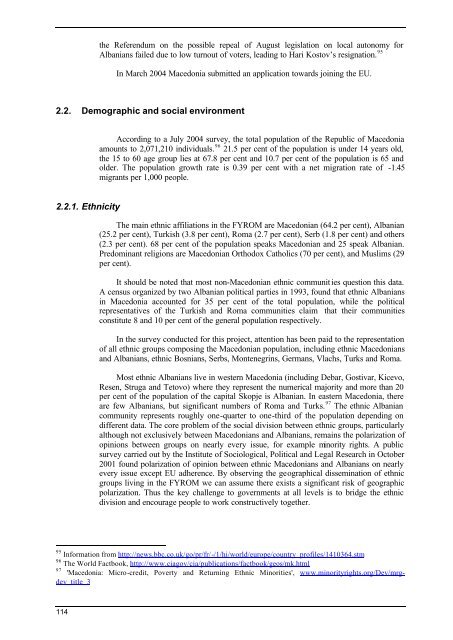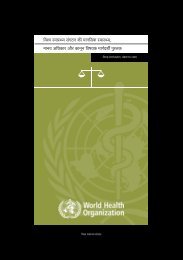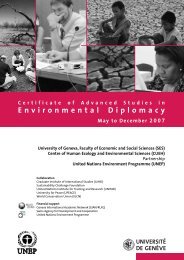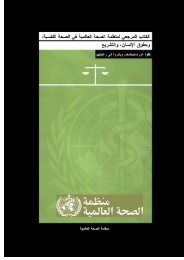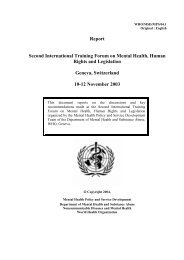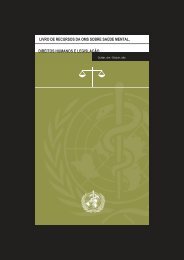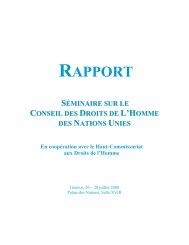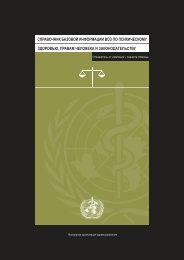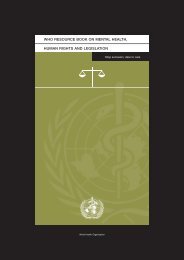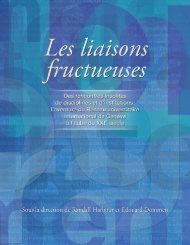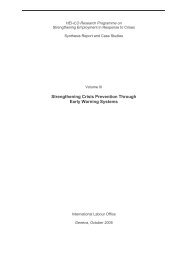the Referendum on the possible repeal of August legislation on local autonomy forAlbanians failed due to low turnout of voters, leading to Hari Kostov’s resignation. 95In March 2004 Macedonia submitted an application towards joining the EU.2.2. Demographic and social environmentAccording to a July 2004 survey, the total population of the Republic of Macedoniaamounts to 2,071,210 individuals. 96 21.5 per cent of the population is under 14 years old,the 15 to 60 age group lies at 67.8 per cent and 10.7 per cent of the population is 65 andolder. The population growth rate is 0.39 per cent with a net migration rate of -1.45migrants per 1,000 people.2.2.1. EthnicityThe main ethnic affiliations in the FYROM are Macedonian (64.2 per cent), Albanian(25.2 per cent), Turkish (3.8 per cent), Roma (2.7 per cent), Serb (1.8 per cent) and others(2.3 per cent). 68 per cent of the population speaks Macedonian and 25 speak Albanian.Predominant religions are Macedonian Orthodox Catholics (70 per cent), and Muslims (29per cent).It should be noted that most non-Macedonian ethnic communit ies question this data.A census organized by two Albanian political parties in 1993, found that ethnic Albaniansin Macedonia accounted for 35 per cent of the total population, while the politicalrepresentatives of the Turkish and Roma communities claim that their communitiesconstitute 8 and 10 per cent of the general population respectively.In the survey conducted for this project, attention has been paid to the representationof all ethnic groups composing the Macedonian population, including ethnic Macedoniansand Albanians, ethnic Bosnians, Serbs, Montenegrins, Germans, Vlachs, Turks and Roma.Most ethnic Albanians live in western Macedonia (including Debar, Gostivar, Kicevo,Resen, Struga and Tetovo) where they represent the numerical majority and more than 20per cent of the population of the capital Skopje is Albanian. In eastern Macedonia, thereare few Albanians, but significant numbers of Roma and Turks. 97 The ethnic Albaniancommunity represents roughly one-quarter to one-third of the population depending ondifferent data. The core problem of the social division between ethnic groups, particularlyalthough not exclusively between Macedonians and Albanians, remains the polarization ofopinions between groups on nearly every issue, for example minority rights. A publicsurvey carried out by the Institute of Sociological, Political and Legal Research in October2001 found polarization of opinion between ethnic Macedonians and Albanians on nearlyevery issue except EU adherence. By observing the geographical dissemination of ethnicgroups living in the FYROM we can assume there exists a significant risk of geographicpolarization. Thus the key challenge to governments at all levels is to bridge the ethnicdivision and encourage people to work constructively together.95 Information from http://news.bbc.co.uk/go/pr/fr/-/1/hi/world/europe/country_profiles/1410364.stm96 The World Factbook, http://www.ciagov/cia/publications/factbook/geos/mk.html97'Macedonia: Micro-credit, Poverty and Returning Ethnic Minorities', www.minorityrights.org/Dev/mrgdev_title_3114
2.2.2. PovertyAfter the break-up of the Yugoslav federation, the FYROM has emerged as a countrywith high poverty and unemployment rates. According to the official poverty line,approximately 20 per cent of the population is poor and the poor live mainly in rural areas.This social group may be related to three categories: the traditional poor (mainly the ruralpoor), the new poor (those affected by the transition, mainly non-agricultural households)and the chronic poor comprising the elderly, the disabled, the aged non-pensioners andother disadvantaged groups. Poverty characteristics include low level of ownership, largehousehold size and low access to education, health and social services. Anothercharacteristic of poverty is its regional distribution. The south-western and south-easternPoloski and Skopski regions recorded high levels of poverty, while rates in other regionswere below the national average. Living conditions of the poor are badly affected by therun-down state of the country’s economic services, primarily school, health facilities,water supplies, sanitation and neighbourhood access roads.2.2.3. The gender dimensionGenerally, women are well represented in public sector activities in urban areas,reflecting the provisions for gender equality in Article 9 of the Constitution of the FYROMwhich includes a special provision for protecting mothers. 98 Gender equality is alsoembedded in a number of other laws such as those linked to labour relations, trade unionsand defence. In the public administration, for example, one of every two posts is coveredby a woman.However, gender disparities are still strong in the private sector and other areas of theeconomy. A recent labour survey showed women hired in the private sector accounted forless than 30 per cent of the total workforce. In rural areas, more women engage inhousehold activities than their urban counterparts, and are far less represented inemployment in the broader activities of their communities as well as in local government.Another significant feature is that ethnic Albanian and Roma women lag behind theirethnic Macedonian counterparts in education attainment levels, participation in the labourmarket and social activities.2.3. Economic environmentThe economy has partly recovered from the steep depression of the 1990s linked tothe break-up of the Former Yugoslavia, the subsequent conflict and the embargo (includingthe Greek blockade in the early 1990s).Gross Domestic Product (GDP) estimates for 2003 stood at 13.81 billion US$ and theGDP growth rate for the same year stood at 2.8 per cent. The composition of GDP persector is agriculture- 11.3 per cent, industry- 32.1 per cent and services- 56.6 per cent,whereas Investment (gross fixed) represented 16.13 per cent of the GDP. 99 The extremelyhigh unemployment rate (approx. 32 per cent) is one of the most pressing socio-economicproblems facing Macedonia. Unemployment figures have stagnated over the past decadedue to a recession following the implosion of The Socialist Federal Rebublic of Yugoslaviain 1991, and a transition process that is yet to reap the full benefits of the market economy.There is a heavy concentration of unemployment among the Roma, Albanian and Turkish98‘Enterprise Development Strategy. Small and Medium-Sized Enterprises.’, Inter-Development Group,http://www.iadb.org/sds/doc/759eng.pdf99 For more detailed and comparative data see Annex 4.115
- Page 1 and 2:
HEI-ILO Research Programme onStreng
- Page 3:
PrefaceThis three-volume series res
- Page 7 and 8:
Table of contentsPreface...........
- Page 9:
The Private Sector and Social Partn
- Page 13:
Executive summaryPrivate enterprise
- Page 16 and 17:
IGOs, NGOs—tend to exclude, or at
- Page 18 and 19:
• The World Bank has created a kn
- Page 20 and 21:
2. Private enterprises in conflict-
- Page 22 and 23:
Figure 1: The Private Sector Employ
- Page 24 and 25:
2.3. Case study: Promoting multi-et
- Page 26 and 27:
downstream, i.e. refining and distr
- Page 28 and 29:
Box 1: How does Somalia’s private
- Page 30 and 31:
Sectoral aspectsthere will be added
- Page 32 and 33:
inequities in pricing. “Of the 16
- Page 34 and 35:
into the armies are thereby also at
- Page 36 and 37:
3. Private enterprises and social p
- Page 38 and 39:
Two natural disasters which have be
- Page 40 and 41:
Box 4: Cooperatives in crisis respo
- Page 42 and 43:
partners, the tripartite cooperatio
- Page 44:
36forces and that are able to perfo
- Page 48:
AcknowledgmentsThe authors of this
- Page 51 and 52:
6.2. Delimiters of women’s econom
- Page 54 and 55:
Executive summaryDespite the rich n
- Page 56 and 57:
1. IntroductionSince 1979, under th
- Page 58 and 59:
2. Country profileThe Republic of I
- Page 60 and 61:
• activities related to reconstru
- Page 62 and 63:
for university education concerning
- Page 64 and 65:
2.4. Economic environment assessmen
- Page 66 and 67:
Unemployment (15 years of age and a
- Page 68 and 69:
2.5. PerspectivesDespite devastatio
- Page 70 and 71:
3. The rationale of SME sector deve
- Page 72 and 73: 4. Iraq's SME sector: A profile4.1.
- Page 74 and 75: The Private sector employment pyram
- Page 76 and 77: Table 8: Estimates of total formal
- Page 78 and 79: Feasibility study: almost all respo
- Page 80 and 81: Table 9: Percentage of female entre
- Page 82 and 83: Factors for public sector preferenc
- Page 84 and 85: The recessionary indication of busi
- Page 86 and 87: Special investment legislation and
- Page 88 and 89: 8. Small entrepreneurs in Iraq: Sto
- Page 90 and 91: a reasonable income and independenc
- Page 92 and 93: 9. RecommendationsSME-development s
- Page 94 and 95: Longer-term SME developmentBesides
- Page 96 and 97: • literature and artistic service
- Page 98 and 99: 2. List of interviews with governme
- Page 100 and 101: 11. Why did you decide establishing
- Page 102 and 103: 33. What are the cost components of
- Page 104 and 105: 59. Are you working on a project, o
- Page 106: Promoting multi-ethnic stakeholder
- Page 109 and 110: 101
- Page 111 and 112: 103
- Page 113 and 114: 105
- Page 115 and 116: 107
- Page 117 and 118: 109
- Page 119 and 120: Research methodologyThe research te
- Page 121: possibility of conflict. In 1992, a
- Page 125 and 126: of almost 10 per cent of GDP, yet i
- Page 127 and 128: Source of initial financing: privat
- Page 129 and 130: ‘It is important to point out tha
- Page 131 and 132: 4.2. The economic resilience of int
- Page 133 and 134: medium-sized companies employing 24
- Page 135 and 136: 5.2. Addressing constraints for SME
- Page 137 and 138: 5.4. Support to local initiativesSM
- Page 139 and 140: ConclusionConsidering the actual an
- Page 141 and 142: Scott, Norman: Macedonia: A Brief E
- Page 143 and 144: Official gross reserves 4 290 450 7
- Page 145 and 146: 4. Survey questionnaire1. Name of t
- Page 147 and 148: 139
- Page 149 and 150: 141
- Page 151 and 152: 143
- Page 153 and 154: 2. Le contexte2.1. Le paradoxe ango
- Page 155 and 156: Composition et description des Futu
- Page 157 and 158: Les généraux angolais sont prése
- Page 159 and 160: Les syndicats officielsL’Union na
- Page 161 and 162: Une étude réalisée en 2003 pour
- Page 163 and 164: 3.3. Sortir du cercle vicieux : vie
- Page 165 and 166: Annexes1. Morceaux choisis : le «
- Page 167 and 168: 159
- Page 169 and 170: L’implication des partenaires soc
- Page 171 and 172: Table des matièresTable des matiè
- Page 173 and 174:
RemerciementsQu’il me soit permis
- Page 175 and 176:
Liste des acronymesAFASPAALEANEAANS
- Page 177 and 178:
GlossaireAide d’urgence :Aléa :A
- Page 179 and 180:
Résumé exécutifAu cours des dix
- Page 181 and 182:
1. IntroductionLe département de R
- Page 183 and 184:
Limites de l’étudeAvant de proc
- Page 185 and 186:
évalué à plus de deux milliards
- Page 187 and 188:
2.2.2. Aspects démographiquesLes p
- Page 189 and 190:
2.3.3. EducationDès l’indépenda
- Page 191 and 192:
création de fonds de stabilisation
- Page 193 and 194:
3. Analyse des formes de réponse :
- Page 195 and 196:
• le secteur de l’Eau sera dest
- Page 197 and 198:
• la révision de la législation
- Page 199 and 200:
de main-d’œuvre, encourageant la
- Page 201 and 202:
leur fournissait les équipements e
- Page 203 and 204:
matérielle sous des formes diverse
- Page 205 and 206:
centre de l’attention des partena
- Page 207 and 208:
• le rôle dévolu à la commissi
- Page 209 and 210:
Renforcer le rôle de solidarité d
- Page 211 and 212:
ConclusionLa dimension de la tache
- Page 213 and 214:
Equipe Multidisciplinaire pour l’
- Page 215 and 216:
2. Séries statistiquesTable 8 : Ev
- Page 217 and 218:
Table 11 : Répartition de la popul
- Page 219 and 220:
Table 2 : Liste détaillée des com
- Page 221 and 222:
Table 4 : Dispositif d’interventi
- Page 223 and 224:
Organisation de l’unité syndical
- Page 225 and 226:
- Centre technique de construction.
- Page 227:
219


